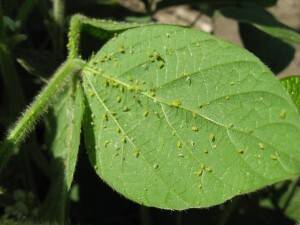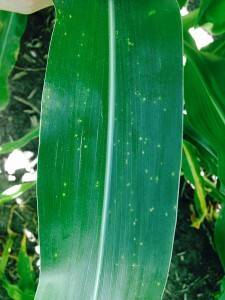Watch for Leaf Diseases & Pest Pressure
In yesterday’s weekly crop updates, our regional sales managers (RSMs) reported seeing leaf diseases and pest pressure as they’ve been walking fields. Watch for these three situations in your soybean fields: (1) Soybean Aphids; (2) Soybean Cyst Nematodes (SCN); and (3) Sudden Death Syndrome (SDS). Also check your corn fields for Northern Corn Leaf Blight and Eye Spot.
None of our regional sales managers have reported soybean aphids at threshold levels of 250 aphids per  plant on 80% of the plants, but RSMs this week reported aphid citings. Remember, aphid populations can double every two to three days! With the varying stages of soybean development due to an extended planting season and many late replants, continue scouting past your first insecticide application.
plant on 80% of the plants, but RSMs this week reported aphid citings. Remember, aphid populations can double every two to three days! With the varying stages of soybean development due to an extended planting season and many late replants, continue scouting past your first insecticide application.
Taking the time to scout for SCN within the next few weeks may not be at the top of your “to do list,” but perhaps it should be! Soybean Cyst Nematode is the number one yield robber of soybeans. Digging root samples is the best way to check for SCN; SCN females will be on soybean roots that are easy to dig from the soil through early August.
SCN is usually associated with SDS. Sudden Death Syndrome infects soybean plants right after germination and emergence, but symptoms generally do not appear until mid- to late summer. Leaf symptoms first appear as yellow spots between leaf veins. Eventually, the leaves turn yellow and brown streaks develop between the leaf veins while the veins remain green. Leaflets eventually drop but the petioles remain on the stem. Diseased plants may have rotted root systems.
The most effective way to manage SCN and SDS is through quality soybean seed selection. Latham® IronCladTM Soybeans offer unmatched protection. To bear the IRONCLAD distinction, each Latham soybean brand must be SCN resistant and carry an Iron Deficiency Chlorosis rating of 2.2 or better. It also must contain a Phytophthora-resistant gene as well as a very good rating (2.2 or better) against Brown Stem Rot and either White Mold or Sudden Death Syndrome.
Just as wet planting conditions followed by humid summer weather makes prime conditions for soybean pests, the same holds true for corn leaf diseases. Plentiful moisture or dew is ideal for most fungal corn diseases. Watch for Gray Leaf Spot, Southern and Common Rust, Northern & Southern Leaf Blight and Eyespot.
Scout corn fields prior to tassel emergence, around V14 growth stage, to determine disease pressure.  Fungicides may help but consider cost and predicted weather conditions first. To prevent Northern Corn Leaf Blight (NCLB) from becoming a larger problem in the future, rotate to a non-host crop. A two-year rotation away from corn may be necessary in no-till and reduced tillage fields with a history of NCBL. Hybrid selection is also key for reducing future threats of NCLB.
Fungicides may help but consider cost and predicted weather conditions first. To prevent Northern Corn Leaf Blight (NCLB) from becoming a larger problem in the future, rotate to a non-host crop. A two-year rotation away from corn may be necessary in no-till and reduced tillage fields with a history of NCBL. Hybrid selection is also key for reducing future threats of NCLB.
Cool temperatures, humid and wet conditions, continuous corn, conservation tillage, and susceptible corn hybrids/inbreds favor Eyespot. Once again, selecting resistant corn hybrids is key to managing this disease in the future. Other management strategies include crop rotation and tillage to reduce corn residue.
Take good field notes now to help you select the right seed for the future. It’s not too soon to place your 2016 seed order! Latham Hi-Tech Seeds last week took delivery of its new seed product guides. Contact your local Latham® dealer or contact us online for more information.